
Below is a list of national emblems and coats of arms used by Asian countries, territories and regions.

Below is a list of national emblems and coats of arms used by Asian countries, territories and regions.
| State | National emblem / Coat of arms | Motto / Text | Main article |
|---|---|---|---|
| Afghanistan [lower-alpha 1] |  | لا إله إلا الله محمد رسول الله (Arabic: "There is no god but Allah, Muhammad is the messenger of Allah") | Emblem of Afghanistan |
 | |||
| Armenia |  | none | Coat of arms of Armenia |
| Azerbaijan |  | none | National emblem of Azerbaijan |
| Bahrain |  | none | Emblem of Bahrain |
| Bangladesh | 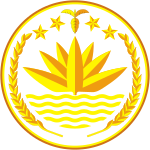 | none | Emblem of Bangladesh |
| Bhutan |  | none | Emblem of Bhutan |
| Brunei |  | الدائمون المحسنون بالهدى بروني دارالسلام (Arabic: "Always beneficent with God's guidance، Brunei as the pace in the end) | Emblem of Brunei |
| Cambodia |  | ព្រះចៅក្រុងកម្ពុជា (Khmer: "King of the Kingdom of Cambodia") | Royal arms of Cambodia |
| China |  | none | National Emblem of the People's Republic of China |
| East Timor | 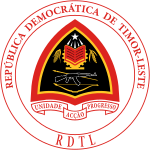 | República Democrática de Timor-Leste (Portuguese: "Democratic Republic of Timor-Leste") (Top) Unidade, Acção, Progresso (Portuguese: "Unity, Action, Progress") (Center) | Coat of arms of East Timor |
| Georgia | 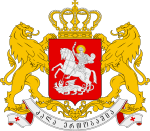 | ძალა ერთობაშია (Georgian: "Strength is in Unity") | Coat of arms of Georgia |
| India |  | सत्यमेव जयते (Sanskrit: "Truth Alone Triumphs") | Emblem of India |
| Indonesia | 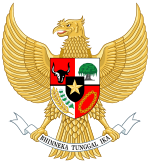 | Bhinneka Tunggal Ika (Old Javanese: "Unity in Diversity") | National emblem of Indonesia |
| Iran |  | none | Emblem of Iran |
| Iraq |  | جمهورية العراق (Arabic: "Republic of Iraq") | Coat of arms of Iraq |
| Israel | 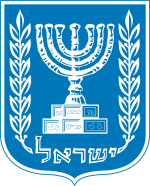 | ישראל (Hebrew: "Israel") | Emblem of Israel |
| Japan |  | none | Imperial Seal of Japan |
| Jordan | 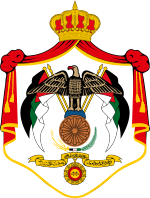 | (Right) الحسين بن طلال بن عبدلله (Arabic: "Al Hussein bin Talal bin Abdullah") (Arabic: "Who seeks support and guidance from Allah") | Coat of arms of Jordan |
| Kazakhstan |  | Qazaqstan (Kazakh: "Kazakhstan") | Emblem of Kazakhstan |
| Kuwait |  | دولة الكويت (Arabic: "State of Kuwait") | Emblem of Kuwait |
| Kyrgyzstan |  | Кыргыз Республикасы (Kyrgyz: "Kyrgyz Republic") | Emblem of Kyrgyzstan |
| Laos |  | (Right) ເອກະພາບ ວັດຖະນາຖາວອນ (Lao: "Unity and Prosperity") (Lao: "Lao People's Democratic Republic") (Lao: "Peace, Independence, Democracy") | Emblem of Laos |
| Lebanon | 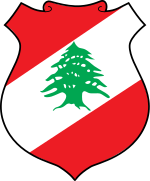 | none | Coat of arms of Lebanon |
| Malaysia | 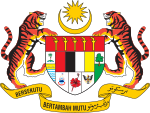 | Bersekutu bertambah mutu (Malay: "Unity is Strength") | Coat of arms of Malaysia |
| Maldives |  | الدولة المحلديبية (Arabic: "State of the Mahal Dibiyat") | Emblem of Maldives |
| Mongolia | 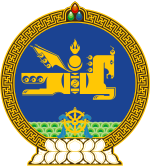 | none | Emblem of Mongolia |
| Myanmar | 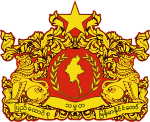 | ပြည်ထောင်စု သမ္မတ မြန်မာနိုင်ငံတော် (Burmese: "Republic of the Union of Myanmar") | State seal of Myanmar |
| Nepal |  | जननी जन्मभूमिश्च स्वर्गादपि गरीयसी (Sanskrit: "The Mother and the Motherland are greater than Heaven") | Emblem of Nepal |
| North Korea |  | 조선민주주의인민공화국 (Korean: "Democratic People's Republic of Korea") | Emblem of North Korea |
| Oman |  | none | National emblem of Oman |
| Pakistan | 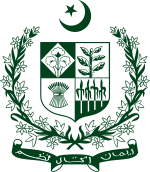 | ایمان، اتحاد، نظم (Urdu: "Faith, Unity, Discipline") | State emblem of Pakistan |
| Palestine |  | فلسطين (Arabic: "Palestine") | Coat of arms of Palestine |
| Philippines |  | Republika ng Pilipinas (Filipino: "Republic of the Philippines") | Coat of arms of the Philippines |
| Qatar |  | none | Emblem of Qatar |
| Russia | 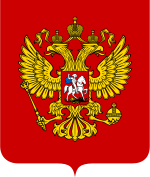 | none | Coat of arms of Russia |
| Saudi Arabia | 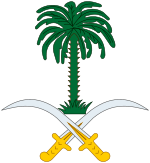 | none | Emblem of Saudi Arabia |
| Singapore | 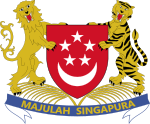 | Majulah Singapura (Malay: "Onward Singapore") | Coat of arms of Singapore |
| South Korea |  | 대한민국 : (Korean: "Republic of Korea") | Emblem of South Korea |
| Sri Lanka | 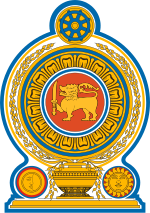 | none | Emblem of Sri Lanka |
| Syria |  | الجمهورية العربية السورية (Arabic: "Syrian Arab Republic") | Coat of arms of Syria |
| Tajikistan |  | none | Emblem of Tajikistan |
| Thailand |  | none | Emblem of Thailand |
| Turkmenistan |  | none | Emblem of Turkmenistan |
| United Arab Emirates |  | الإمارات العربية المتحدة (Arabic: "United Arab Emirates") | Emblem of the United Arab Emirates |
| Uzbekistan | 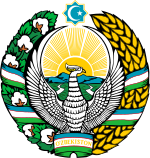 | Oʻzbekiston (Uzbek: "Uzbekistan") | Emblem of Uzbekistan |
| Vietnam |  | Cộng hòa Xã hội chủ nghĩa Việt Nam (Vietnamese: "Socialist Republic of Vietnam") | Emblem of Vietnam |
| Yemen |  | الجمهورية اليمنية (Arabic: "The Republic of Yemen") | Emblem of Yemen |
| State | National emblem / Coat of Arms | Motto / Text | Main article | Other claimants |
|---|---|---|---|---|
| Abkhazia |  | none | Emblem of Abkhazia | Georgia |
| Northern Cyprus | 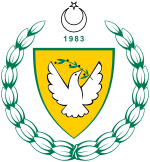 | 1983 | Coat of arms of the Turkish Republic of Northern Cyprus | Cyprus |
| South Ossetia |  | (Top): Республикӕ Хуссар Ирыстон (Bottom): Республика Южная Осетия (Ossetian (Top) and Russian (Bottom): "Republic of South Ossetia") | Coat of arms of South Ossetia | Georgia |
| Republic of China (Taiwan) |  | none | Blue Sky with a White Sun | People's Republic of China (China) |
| Country | Dependency / Territory | National emblem / Coat of arms | Motto / Text | Main article |
|---|---|---|---|---|
| Georgia | Adjara | 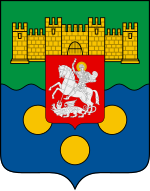 | none | Coat of arms of Adjara |
| United Kingdom | Akrotiri and Dhekelia |  | Dieu et mon Droit (French: "God and my right") | Royal coat of arms of the United Kingdom |
| Philippines | Bangsamoro |  | Bangsamoro Autonomous Region in Muslim Mindanao 2019 | Seal of Bangsamoro |
| United Kingdom | British Indian Ocean Territory | 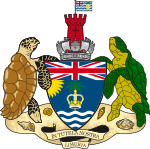 | In tutela nostra Limuria | Coat of arms of the British Indian Ocean Territory |
| People's Republic of China | Hong Kong | 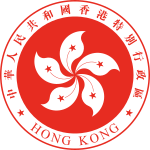 | 中華人民共和國香港特別行政區 (Chinese: "Hong Kong Special Administrative Region of the People's Republic of China") | Emblem of Hong Kong |
| Iraq | Iraqi Kurdistan |  | (Inside) 1992 / حكومه تی هەرێمی كوردستان ١٩٩٢ / حكومة اقليم كوردستان (Bottom) : Kurdistan Regional Government | Coat of arms of the Kurdistan Regional Government |
| People's Republic of China | Macau |  | 中華人民共和國澳門特別行政區 (Chinese: "Macau Special Administrative Region of the People's Republic of China") | Emblem of Macau |
| Azerbaijan | Nakhichevan |  | none | Emblem of Azerbaijan |

The Taliban, which also refers to itself by its state name, the Islamic Emirate of Afghanistan, is an Afghan militant movement with an ideology comprising elements of Pashtun nationalism and the Deobandi current of Islamic fundamentalism. It ruled approximately three-quarters of the country from 1996 to 2001, before being overthrown following the American invasion. It recaptured Kabul on 15 August 2021 following the departure of most coalition forces, after nearly 20 years of insurgency, and currently controls all of the country. Its government is not recognized by any country. The Taliban government has been internationally condemned for restricting human rights in Afghanistan, including the right of women and girls to work and to have an education.

The government of Afghanistan is currently disputed following the effective collapse of the Islamic Republic of Afghanistan during the fall of Kabul to Taliban forces on 15 August 2021 and the subsequent re-establishment of the Islamic Emirate of Afghanistan which now exercises de facto control over most of the country. On 7 September 2021 the Taliban officials in de facto control of most of Afghanistan announced a new interim government headed by Mullah Mohammad Hassan Akhund as Prime Minister. The government is subject to the oversight of the Taliban's Supreme Leader, Haibatullah Akhundzada. As of 8 September 2021, the Islamic Emirate of Afghanistan has not yet been formally recognized as the de jure government of Afghanistan by any other country. The representatives appointed by the Islamic Republic of Afghanistan continue to represent the country at the United Nations. These representatives have refused to recognize the Taliban appointed government and have urged other countries to not recognize this government either.
The following lists events that happened during 2001 in Afghanistan.

The Islamic Emirate of Afghanistan, also referred to as the First Islamic Emirate of Afghanistan, was a totalitarian Islamic state led by the Taliban that ruled most of Afghanistan from 1996 to 2001. At its peak, the Taliban government controlled approximately 90% of the country, while remaining regions in the northeast were held by the Northern Alliance, which maintained broad international recognition as a continuation of the Islamic State of Afghanistan.

The national flag of Saudi Arabia, also known as the al-Alam, is a green background with Arabic inscription and a sword in white. The inscription is the Islamic creed, or shahada: "There is no deity but God; Muhammad is the Messenger of God". The current design has been used by the government of Saudi Arabia since 15 March 1973.

The national flag of the Islamic Emirate of Afghanistan, adopted on 15 August 2021 following the Taliban's victory in the 2001–2021 war, features a white field with a black Shahada inscribed. Since the 20th century, Afghanistan has changed its national flag several times. The national flag had black, red and green colors most of the time during the period.
This gallery of sovereign state flags shows the national or state flags of sovereign states that appear on the list of sovereign states. For flags of other entities, please see gallery of flags of dependent territories. Each flag is depicted as if the flagpole is positioned on the left of the flag, except for those of Iran, Iraq and Saudi Arabia which are depicted with the hoist to the right.

The national emblem of Afghanistan is a national symbol of Afghanistan that has appeared in some form on the flag of Afghanistan since 1901.
This armorial of sovereign states shows the coat of arms, national emblem, or seal for every sovereign state. Although some countries do not have an official national emblem, unofficial emblems which are de facto used as national emblems are also shown below.

The Council of Ministers of the Islamic Emirate of Afghanistan is the executive body of the government of Afghanistan, responsible for day-to-day governance and the implementation of policy set by the Leadership. It is headed by the prime minister—who serves as the nation's head of government—and his deputies, and consists of the heads and deputy heads of the government ministries.

The following outline is provided as an overview of and topical guide to Afghanistan:

The Ministry for the Propagation of Virtue and the Prevention of Vice is the state agency in charge of implementing Islamic law in the Islamic Emirate of Afghanistan as defined by the Taliban. It was first instituted in 1992 by the Rabbani government of the Islamic State of Afghanistan and adopted in 1996 by the Taliban government of the Islamic Emirate of Afghanistan of 1996–2001. The ministry was restored in the reinstated Islamic Emirate in September 2021 after the August fall of Kabul.

The Afghan conflict refers to the series of events that have kept Afghanistan in a near-continuous state of armed conflict since the 1970s. Early instability followed the collapse of the Kingdom of Afghanistan in the largely non-violent 1973 coup d'état, which deposed Afghan monarch Mohammad Zahir Shah in absentia, ending his 40-year-long reign. With the concurrent establishment of the Republic of Afghanistan, headed by Mohammad Daoud Khan, the country's relatively peaceful and stable period in modern history came to an end. However, all-out fighting did not erupt until after 1978, when the Saur Revolution violently overthrew Khan's government and established the Democratic Republic of Afghanistan. Subsequent unrest over the radical reforms that were being pushed by the then-ruling People's Democratic Party of Afghanistan (PDPA) led to unprecedented violence, prompting a large-scale pro-PDPA military intervention by the Soviet Union in 1979. In the ensuing Soviet–Afghan War, the anti-Soviet Afghan mujahideen received extensive support from Pakistan, the United States, and Saudi Arabia in a joint covert effort that was dubbed Operation Cyclone.

"Fortress of Islam, Heart of Asia" is an Afghan mujahidin battle song composed in 1919 by Ustad Qasim. It was adopted as the national anthem of the Islamic State of Afghanistan from 1992 to 2006.

The Afghan Armed Forces, officially the Armed Forces of the Islamic Emirate of Afghanistan also referred to as the Islamic Emirate Armed Forces, is the military of Afghanistan, commanded by the Taliban government from 1997 to 2001 and since August 2021. According to Afghanistan's Ministry of Defense, its total manpower is 170,000.

The Islamic Republic of Afghanistan was a presidential republic that ruled Afghanistan from 2004 to 2021. The state was established to replace the Afghan interim (2001–2002) and transitional (2002–2004) administrations, which were formed after the 2001 United States invasion of Afghanistan that had toppled the partially recognized Taliban-ruled Islamic Emirate of Afghanistan. However, on 15 August 2021, the country was recaptured by the Taliban, which marked the end of the 2001–2021 war, the longest war in US history. This led to the overthrow of the Islamic Republic, led by President Ashraf Ghani, and the reinstatement of the Islamic Emirate under the control of the Taliban. While the United Nations still recognizes the Islamic Republic as the legitimate government of Afghanistan, this toppled regime controls no portion of the country today, nor does it operate in exile; it effectively no longer exists. The Islamic Emirate is the de facto ruling government. The US–Taliban deal, signed on 29 February 2020 in Qatar, was one of the critical events that caused the collapse of the Afghan National Security Forces (ANSF). Following the deal, the US dramatically reduced the number of air attacks and deprived the ANSF of a critical edge in fighting the Taliban insurgency, leading to the Taliban takeover of Kabul.

The Taliban has ruled Afghanistan as the Islamic Emirate of Afghanistan since taking control by force in 2021, overthrowing the internationally recognized Islamic Republic of Afghanistan. The takeover was widely criticized by the international community, and no countries have extended de jure diplomatic recognition to the new regime, despite nominally maintaining relations with Afghanistan. The Taliban has campaigned for international recognition since the takeover. Several countries have vowed never to recognize the Islamic Emirate, and others have said they will do so only if human rights in the country are respected. Some countries have accredited Taliban diplomats at the chargé d'affaires level despite not recognizing the Islamic Emirate. In September 2023, the People's Republic of China became the first country to formally name a new ambassador to the country since the takeover, and in January 2024 recognized the Taliban's envoy to China; however, the PRC still does not formally recognize the Taliban as the legitimate government of Afghanistan.
The politics of Afghanistan are based on a totalitarian emirate within the Islamic theocracy in which the Taliban Movement holds a monopoly on power. Dissent is not permitted, and politics are mostly limited to internal Taliban policy debates and power struggles. As the government is provisional, there is no constitution or other basis for the rule of law. The structure is autocratic, with all power concentrated in the hands of the supreme leader and his clerical advisors. According to the V-Dem Democracy indices Afghanistan was as of 2023 the 4th least electoral democratic country in the world.
The government of Afghanistan, officially called the Islamic Emirate of Afghanistan, is the central government of Afghanistan, a unitary state. Under the leadership of the Taliban, the government is a theocracy and an emirate with political power concentrated in the hands of a supreme leader and his clerical advisors, collectively referred to as the Leadership. The Leadership makes all major policy decisions behind closed doors, which are then implemented by the country's civil service and judiciary. As Afghanistan is an Islamic state, governance is based on Sharia law and Pashtunwali, which the Taliban enforces strictly through extensive social and cultural policy.